 Leisure and Cultural Services Department - Hong Kong ParkLeisure and Cultural Services Department
Leisure and Cultural Services Department - Hong Kong ParkLeisure and Cultural Services Department
The Edward Youde Aviary of Hong Kong Park
Design Concept
The Edward Youde Aviary of Hong Kong Park has been open to public since September 1992. The aviary is named after the late Sir Edward Youde, the Governor of Hong Kong from 1982 to 1986.
|
The aviary has a raised walkway that allows visitors to walk through the tree canopy, from which they can watch the birds, trees and plants at various elevations and the whole valley from different angles. The walkway is wheelchair accessible. The valley floor of the aviary is a streambed full of trees and shrubs, and adorned with shallow pools and small waterfalls. Water goes down the valley and flows into a large pool, which is contiguous with a small lake outside the exit of the aviary and offers a nice place for watching waterfowl. Display panels with graphic and textual illustrations are erected at the entrance of the aviary to explain the structure and ecology of a tropical rain forest, with particular reference to the bird communities in the aviary. |
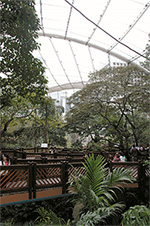 |
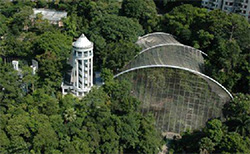 |
To avoid the presence of unsightly supporting poles inside the aviary, the suspending stainless steel mesh spanning the entire valley are supported by four giant arches. The area enclosed by the mesh is approximately 3 000 square metres, with its highest point 30 metres above the valley floor. Apart from preserving the trees on site, additional planting has been carried out both inside and outside the aviary. The trees and plants help conceal the steel mesh from view and make the aviary resemble a natural environment. |
Display Theme
|
The birds are indigenous to the Malesian rain forests. Malesia is a botanical region covering a vast area extending from the Malaya Peninsula and Great Sundas (Sumatra, Borneo and Java), the Philippines, the Indonesian islands to New Guinea and the Bismarck Archipelago. These rain forests are home to the tallest rain forest trees on earth and a large number of animal species including some of the world’s most beautiful birds. Sadly, these forests have been subject to destruction on a massive scale and are under constant and serious threat. As a result, many bird species are threatened with extinction. Although it is not possible to recreate a rain forest, we have created a similar habitat to allow visitors to enjoy the sights and sounds of spectacular birds in a natural environment. |
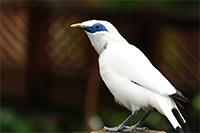 |
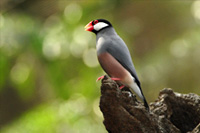 |
Bird Species
The aviary features around 530 birds of 60 different species, mostly indigenous to Malesia. Ground dwelling birds include pheasants, partridges, pigeons and thrushes. Some like the crowned pigeons and golden pheasants are spectacularly beautiful.
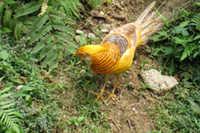 |
The aviary also houses Barbets, which are characteristic birds of the forests in the western part of Malesia and their repetitive calls are common in that region. Songbirds like Shamas and Yellow-crowned Bulbuls often sing loud, melodious songs against a background of various bird calls, making the aviary resemble a rain forest. There are also other passerine birds such as brightly coloured Fairy Bluebirds, bulbuls and leafbirds. |
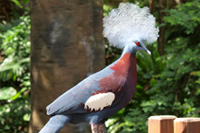 |
The aviary is home to variety of endangered bird species including Bali Mynas, which have beautiful snow-white plumage with bare skin in bright blue around the eyes and a long backward-sweeping crest. They often fly between the trees and the raised walkway in the aviary, singing and chattering delightfully. Although many arboreal doves and pigeons have brightly coloured plumage, they can be difficult to pick out when perching in the tree foliage. On the contrary, Rainbow Lorikeets, Black-capped Lories and Alexandrine Parakeets are attractive to visitors and easy to trace as they often fly around the aviary. |
Java Sparrows are commonly used as fortune-telling birds. They are highly socialised, foraging for food in groups. Although small in size, they work together to carry nesting materials that are bigger than their bodies. Their strength and co-operation are indeed amazing.
|
The Waterfowl Lake is landscaped to form a swamp to accommodate different species of waterfowl. Common Shelducks, an especially attractive species, are often found swimming in the lake leisurely. It is a pity that not all spectacular species can be housed in the aviary. For example, large hornbills have to be kept separately in the display cages as they prey on smaller birds. |
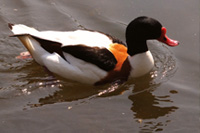 |
Topography and Vegetation
The Edward Youde Aviary, located at the southern corner of Hong Kong Park, is built along a natural valley on the northern slope of Victoria Peak.
Major trees species include Fig, Pond Spice, Tree Cotton, Kapok Tree and Candlenut Tree. A variety of palms and tree ferns are also planted to enrich the forest vegetation. The forest floor is lined with deep leaf litter along with ferns and other typical forest plants that serve as ground covers.
The giant trees in rain forest, with huge buttress and stilt roots, take several hundred years to grow and can hardly reach maturity under the climatic conditions of Hong Kong. Nevertheless, they can be seen in the aviary as accurate imitations specially provided on site.
Caged Display Area
| As complementary facilities, three display cages are erected on a terrace above the valley to house hornbills and other bird species from the Malaysian region. Visitors can watch these birds in close proximity. | 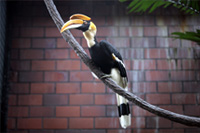 |
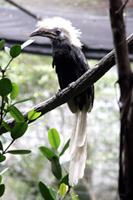 |
Educational Programme and Guided Tour Service
Outdoor learning activities for students will be organised during school terms. Interested groups may make prior arrangement with the Park Management Office for the guided tour service.

